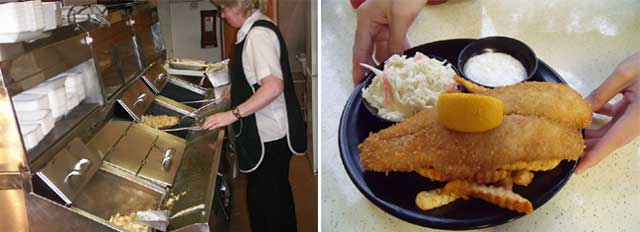 |
5) ‘Excuse Me, Waiter. There’s a Shark in My Food.’
Some environmental groups have substantiated that spiny dogfish numbers are down worldwide. But try to tell that to fishermen who still believe there are too many of these ugly fish (distant cousins to sharks), which ultimately tear up fishing nets. One solution, a few years back, was to start harvesting these unattractive fish and market them to the fried fish crowd. This may have something to do with a measurable drop in dogfish numbers. Many British fish and chip shops started serving dogfish under the assumed name of rock salmon. Restaurants that served dogfish along the Eastern Seaboard of the U.S. called it cape shark. Yikes!
6) Batter or Breadcrumbs?
Enough already about the fish, let’s talk coating. Most fish gets battered in Great Britain, usually with a water and flour mixture, yet beer batters are popular as well–the carbonation in the beer, or ale, as it’s called there, makes for a light coating. Brits and Scots, especially the latter, like to batter and fry just about anything, including candy bars. Fish and chips in America, depending upon what seaboard you’re on, come beer-battered or egg-washed and rolled in breadcrumbs. It’s common to see panko-breaded fish on the West Coast, thanks to that seaboard’s strong Japanese influence. But don’t expect Ivar’s in Seattle to start using panko any time soon.
7) The Chips Are All Wrong
Chips in England are slab-cut potatoes known to most Americans as steak fries. These wedge-cut chips hold up well in the fryer and taste great splashed with malt vinegar. Although some American fish and chip shops serve thicker fries, many places dish up a thinner fried spud that frustrates Britophiles to no end. Some fish and chip aficionados say that the potato must be slab-cut in order for the dish to be authentic. More importantly, though, is whether the restaurant actually hand-cuts its own chips. You can definitely taste the difference between fresh spuds and a frozen product.
8) Honey, Don’t Smother Your Fish
Tartar sauce is expected when you order fish and chips in America. But in Great Britain, this mayonnaise-based dipping sauce is not as popular–not to say it doesn’t exist, though. (Malt vinegar is the preferred sauce there.) In America, there are many variations of tartar sauce, including ones made with dill pickles or capers. Also common is sweet pickle tartar sauce, which tends to be cloyingly strong. It’s hard to taste the fish when you completely cover it with tartar sauce. Try just a squirt of lemon and a splash of malt vinegar–you might be surprised. Save the tartar sauce for the chips.
